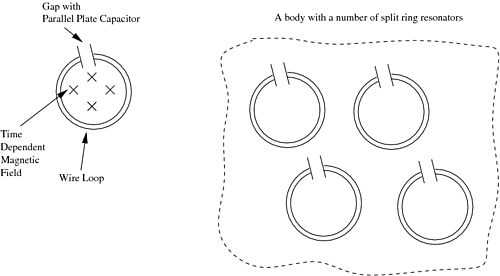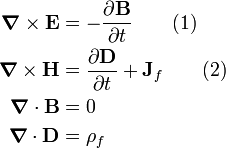Waves in composites and metamaterials/Maxwell equations in media
< Waves in composites and metamaterialsThe content of these notes is based on the lectures by Prof. Graeme W. Milton (University of Utah) given in a course on metamaterials in Spring 2007.
Maxwell's Equations in Media
The time-dependent Maxwell's equations in media (in the absence of any internal sources of magnetic induction) can be written as
where  is electric field,
is electric field,  is the magnetic induction,
is the magnetic induction,  is the magnetic field intensity,
is the magnetic field intensity,  is the electric displacement field due to the movement of bound charges,
is the electric displacement field due to the movement of bound charges,  is the free current density, and
is the free current density, and  is the free charge density. The vector
is the free charge density. The vector  represents the position in space and
represents the position in space and  is the time.
is the time.
We can derive the equation for the conservation of charge by taking the divergence of equation (2) to get
The primary variables in the above equations are  and
and  . The quantities
. The quantities  and
and  are obtained through the constitutive relations
are obtained through the constitutive relations
where  is the rank 2 magnetic permeability tensor of free space,
is the rank 2 magnetic permeability tensor of free space,  is the permittivity tensor,
is the permittivity tensor,  is the magnetization
vector, and
is the magnetization
vector, and  is the polarization vector. The magnetization vector
is the polarization vector. The magnetization vector  measures the net magnetic dipole moment per unit volume. This dipole is associated with electron or nuclear spins. The polarization vector
measures the net magnetic dipole moment per unit volume. This dipole is associated with electron or nuclear spins. The polarization vector  measures the net electric dipole moment per unit volume and is caused by the close proximity of two charges of opposite sign. A point electric dipole is obtained when the distance between two charges tends to zero.
measures the net electric dipole moment per unit volume and is caused by the close proximity of two charges of opposite sign. A point electric dipole is obtained when the distance between two charges tends to zero.
Artificial Magnetic Materials (Metamaterials)
A clear definition of metamaterials does not exist yet. Some authors define metamaterials as those whose properties depend strongly on the geometry of the microstructure but appear not to depend on the properties of the constituents. This definition is not accurate because the effective properties of metamaterials do depend on the properties of the constituents as they must. Another definition is that metamaterials are those materials whose properties do not reflect everyday experience such as negative refractive indexes or negative Poisson's ratios. A more accurate definition can be based on the the fact that many of the properties of metamaterials are due to specific resonances. One such example is stained glass where the resonance of gold particles in the glass gives the glass a red tint.
The fact that artificial magnetic materials may be created from relatively non-magnetic materials was first briefly hinted by Shelkunoff and Friis ([Shelku52], pp. 584-585). The idea was developed in more detail by Pendry and coworkers [Pendry99].
In that work, split ring resonators were used to develop a magnetic material containing non-magnetic components. A schematic of the split ring resonator is shown in Figure 1.
 Figure 1. Split ring resonator. |
If the magnetic field intensity  is time-dependent and the magnetization
vector
is time-dependent and the magnetization
vector  is zero, then
is zero, then
Therefore, there is a non-zero electric field around the loop which implies
that there is a current in the split ring. Now if we place a parallel plate
capacitor in the gap, charges build up in the capacitor and the current
oscillates back and forth in the ring as the field  changes. The
result is that the ring resonates and the net magnetic dipole moment
changes. The
result is that the ring resonates and the net magnetic dipole moment  becomes non-zero.
becomes non-zero.
It is not clear how  should be defined and whether Maxwell's equation should be modified. Avoiding these issues for the moment, we assume that
should be defined and whether Maxwell's equation should be modified. Avoiding these issues for the moment, we assume that
- The free current density (
 ) arises only from conduction currents arising from the response of the medium and not from beams of charged particles.
) arises only from conduction currents arising from the response of the medium and not from beams of charged particles. - In the far distant past (
 ) all field are zero.
) all field are zero.
Define
Then
Taking the divergence of (3) and using the conservation of charge, we get
Therefore, we can write Maxwell's equations in terms of  as
as
This reduction reflects the fact that it is difficult to distinguish the
free current density  from currents arising from the electric
displacement field through
from currents arising from the electric
displacement field through  .
.
To complete the system of equations (4), we need relations
between the fields  ,
,  ,
,  , and
, and  . Some further
assumptions need to be made at this point:
. Some further
assumptions need to be made at this point:
- We assume that only
 is coupled with
is coupled with  and that
and that  is only coupled with
is only coupled with  . This is a good approximation for many stationary materials. But more generally there is cross coupling between these quantities, for example, in biisotropic and bianisotropic materials.
. This is a good approximation for many stationary materials. But more generally there is cross coupling between these quantities, for example, in biisotropic and bianisotropic materials. - We assume that the relations between
 and
and  , and
, and  and
and  are linear.
are linear. - The net magnetic dipole moment
 (and hence the magnetic field
(and hence the magnetic field  ) cannot depend on future values of
) cannot depend on future values of  . This is the principle of causality.
. This is the principle of causality. - The free current density
 (and hence the electric displacement field
(and hence the electric displacement field  ) cannot depend on future values of
) cannot depend on future values of  .
. - The materials are at rest and their properties do not depend upon time.
Therefore, using superposition, we may write
where  and
and  are rank-2 tensor valued kernel functions. These kernel functions may be singular (such as delta functions) and the integrals should be interpreted in the sense of measure theory under such conditions.
are rank-2 tensor valued kernel functions. These kernel functions may be singular (such as delta functions) and the integrals should be interpreted in the sense of measure theory under such conditions.
We further assume that equations (5) can be approximated as being local in space (this is true for poor conductors but may fail for good conductors due to Debye screening.) This implies that the kernel functions can be chosen in such a way that the integration over space at each point evaluates to 1 and we can write
Note that in Fourier space the above convolutions turn into products. Also,
the limits of integration have been changed to go from  to
to  because the kernel functions have been chosen such that
because the kernel functions have been chosen such that
Next, let us assume that all the fields depend harmonically on time (we can treat more general fields by linear superposition). Then
(treating  as having an infinitesimally small imaginary part so that
the fields are zero at
as having an infinitesimally small imaginary part so that
the fields are zero at  ).
).
Plugging the solutions in equation (7) into equations (4), we can get new expressions for the Maxwell's equations in terms of the amplitudes of the harmonic fields. Thus, we have
or,
Similarly, plugging the equations (7) into equations
(6), we get (using  )
)
or,
where
In general  and
and  are complex, rank-2 tensor quantities.
The integrals in equations (10) converge when the imaginary part
of
are complex, rank-2 tensor quantities.
The integrals in equations (10) converge when the imaginary part
of  is positive (since
is positive (since  when
when  ).
[1]
Now,
).
[1]
Now,  is an analytic function of
is an analytic function of  . Since a sum of analytic functions is analytic and a convergent integral of analytic
functions is also analytic, the functions
. Since a sum of analytic functions is analytic and a convergent integral of analytic
functions is also analytic, the functions  and
and
 are analytic functions of
are analytic functions of  in the upper half
in the upper half
 -plane,
-plane,  .
.
Substituting equations (9) into equations (8), and dropping the hats, we get
These are Maxwell equations at fixed frequency.
Footnotes
- ↑ To see this, observe that
![\exp(-i\omega\tau) = \exp(\text{Im}(\omega)~\tau)
[\cos(\text{Re}(\omega)~\tau) - i\sin(\text{Re}(\omega)~\tau)]](../I/m/3c94a5b5b6711b07a5b3c820193d6a5e.png) .
.
References
[Pendry99]
J. B. Pendry, A. J. Holden, D. J. Robbins, and W. J. Stewart. Magnetism from conductors, and enhanced non-linear phenomena.
IEEE Trans. Microwave Theory Tech., 47(11):2075--2084, 1999.
[Shelku52]
S. A. Shelkunoff and H. T. Friis. Antennas: Theory and Practice. Wiley, New York, 1952.














![\begin{align}
\widehat{\mathbf{H}}(\mathbf{x})~e^{-i\omega t} & = \int_{-\infty}^{\infty} \boldsymbol{\bar{K}}_B(\mathbf{x}, t'-t)\cdot
\left[\widehat{\mathbf{B}}(\mathbf{x})~e^{-i\omega t'}\right]~\text{d}t'
= \left\{
\left[\int_{-\infty}^{\infty} \boldsymbol{\bar{K}}_B(\mathbf{x}, \tau)~e^{-i\omega\tau}~\text{d}\tau\right]\cdot
\widehat{\mathbf{B}}(\mathbf{x})\right\}~e^{-i\omega t} \\
\widehat{\mathbf{D}}(\mathbf{x})~e^{-i\omega t} & =
\int_{-\infty}^{\infty} \boldsymbol{\bar{K}}_E(\mathbf{x}, t'-t)\cdot
\left[\widehat{\mathbf{E}}(\mathbf{x})~e^{-i\omega t'}\right]~\text{d}t'
= \left\{
\left[\int_{-\infty}^{\infty} \boldsymbol{\bar{K}}_E(\mathbf{x}, \tau)~e^{-i\omega\tau}~\text{d}\tau\right]\cdot
\widehat{\mathbf{E}}(\mathbf{x})\right\}~e^{-i\omega t}
\end{align}](../I/m/3dfdd849b36cb2e3697624c1151dafb4.png)
![\text{(9)} \qquad
{
\widehat{\mathbf{H}}(\mathbf{x}) = [\boldsymbol{\mu}(\mathbf{x},\omega)]^{-1}\cdot\widehat{\mathbf{B}}(\mathbf{x}) ~;~~
\widehat{\mathbf{D}}(\mathbf{x}) = \boldsymbol{\epsilon}(\mathbf{x},\omega)\cdot\widehat{\mathbf{E}}(\mathbf{x})
}](../I/m/3cf69e0a187eab8f3670589a0d826833.png)
![\text{(10)} \qquad
{
\left[\boldsymbol{\mu}(\mathbf{x},\omega)\right]^{-1} =
\int_{-\infty}^{\infty} \boldsymbol{\bar{K}}_B(\mathbf{x}, \tau)~e^{-i\omega\tau}~\text{d}\tau ~;~~
\boldsymbol{\epsilon}(\mathbf{x},\omega) =
\int_{-\infty}^{\infty} \boldsymbol{\bar{K}}_E(\mathbf{x}, \tau)~e^{-i\omega\tau}~\text{d}\tau ~.
}](../I/m/829b471db16b0ab7e0a795927fb96d5e.png)
